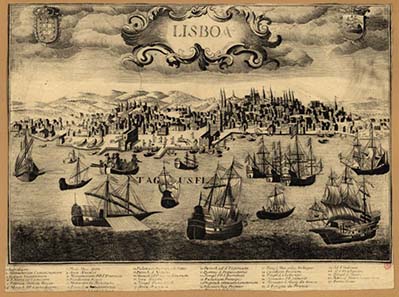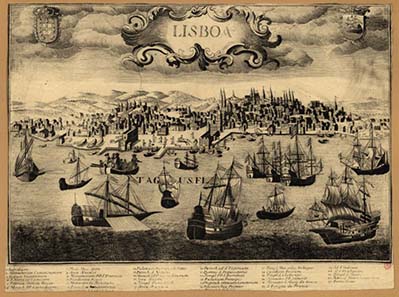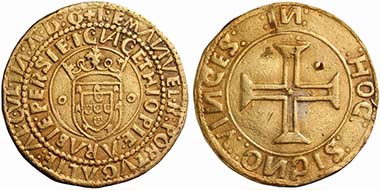Gold for Portugal
Metals are not evenly distributed throughout the world. Whereas in the early 16th century Old Europe was rich in silver and mined tons of the material in the mines of Joachimsthal or near Schwaz, Muslim Africa met its gold requirements from the seemingly inexhaustible deposits in the Sudan. Aurum tiberi – Arabic al-tibr –, that was the name of the gold from the river sand in the Sudan. The ramifications of that imbalance were: in Africa gold was expensive and silver cheap whereas in Europe it was the other way round – and where goods can be acquired for little money in one country and sold at a high price in another, dealers are doing good business.
Lisbon harbour, about 1650.
The gold from the Sudan is one of the few examples that allows tracing back in detail how the commercial routes of the tradesmen ran in those times. At the end of the 15th / beginning of the 16th century, today’s capital of Portugal, Lisbon, acquired a favoured position in the gold trade as a popular interstation. Italian merchants from Genoa or Venice bought gold in the Arab Maghreb that had been transported from the Sudan via the Sahara desert to the Mediterranean coastal towns. They paid with silver, only six times the gold weight. In the North, however, the gold was counterbalanced ten times the value of silver. What was easier than to travel the Atlantic route to the big commercial towns at the North Sea to sell the gold for plenty of money?
Emmanuel I (1495-1521). Português of 10 Cruzados n. d., Lisbon. From auction UBS 50 (2001), no. 28.
The most important reloading point became Portugal where the Arab money was recoined into Portuguese coins. These imposing gold coins worth 10 Cruzados were called Português. Their predecessors go back to 1340. In those days, tradesmen claimed that these Portuguese gold coins weighed as much as “100 Moroccan Doubloons”. Under John II of Castile (1406-1454), these pieces grew to an enormous size; they were produced in weights up to 235 grams. Coins that big were of course never intended to serve as currency in everyday transactions. Basically, they were ingots in the shape of coins whose weight and purity were guaranteed by the national die and hence were easier to trade on the market. In the Northern cities these coin ingots were recoined into local currency or saved as an investment of stable value and hoarded for the case of need. Portuguese large gold coins were very popular in the rich commercial cities in Northern Europe.
Coat of arms of Emmanuel I.
With the gold coins the Portuguese Kings likewise propagated their political agenda in the entire Northern hemisphere. The coins’ reverse show the cross the crusaders affixed to their chest when setting off to fight the Muslims. They have a programmatic legend: In hoc signo vinces (= in this sign you will conquer.). It refers to the vision Constantine is said to have had prior to the Battle of the Milvian Bridge. The Roman Emperor who Christian hagiography praised as protagonist of Christianity allegedly received word by Jesus Christ himself that he would be victorious in the battle to come if he had the cross carried in front of his legions. It is irony of numismatics that this crusaders’ slogan was minted on gold which had been obtained in peaceful trade from the Muslim countries.
Hamburg. Portugaleser of 10 Ducats (1553-1562). Friedberg 1091. From auction Leu Numismatik AG, Zurich 92 (2004), 281.
Northern Europe, far away from Arabia and its Muslims, did not understand a thing about the Hispanic passion for the crusade. Although the Portuguese large gold coins were readily imitated and then called Portugaleser after their model, the reverse’s legend was altered in Hamburg. It was “reduced” to Crucifixo pendit salus n(ost)ra (= On the cross is our salvation).
Hamburg. Bank Portugaleser of 10 Ducats 1679. Gaedechens II, 1615. From auction Leu Numismatik AG, Zurich 92 (2004), 282.
Traditional commercial routes were soon to change. Not from Africa but from the New World the gold was going to come, that, minted in Portugal and Spain, flooded the European money markets. In the first decade of the 16th century, it was only 5 tons of gold heading for Spain from its American colonies but the imports increased significantly. In the middle of the16th century, five tons were transported from overseas each year that were distributed from Spain throughout Europe.
But even though the gold came from Spain and did not run from Portugal to the North anymore, the designation Portugaleser continued to exist – centuries later, that name was still in use for the imposing medals issued in Hamburg.















